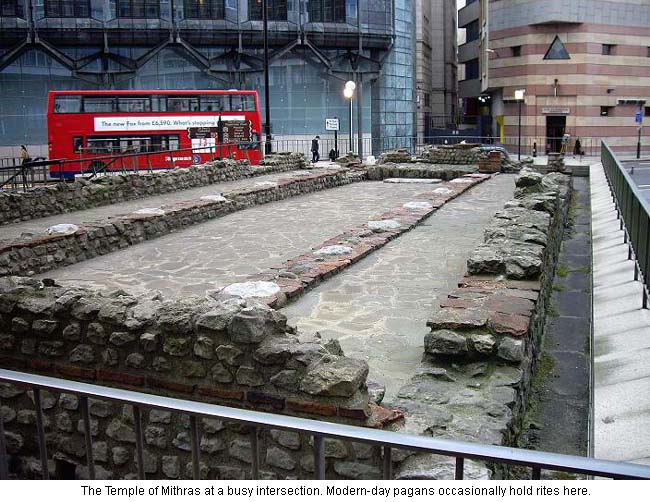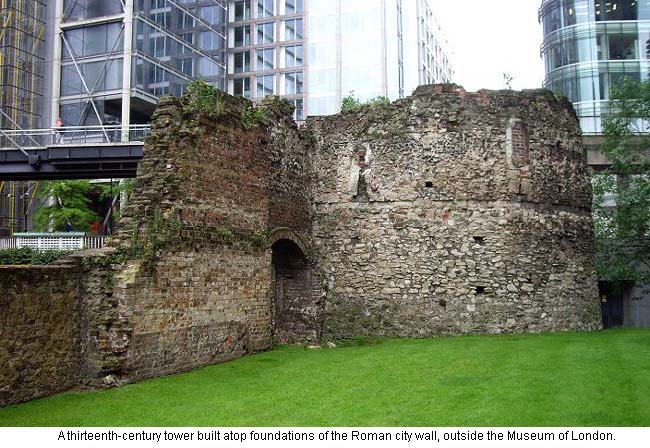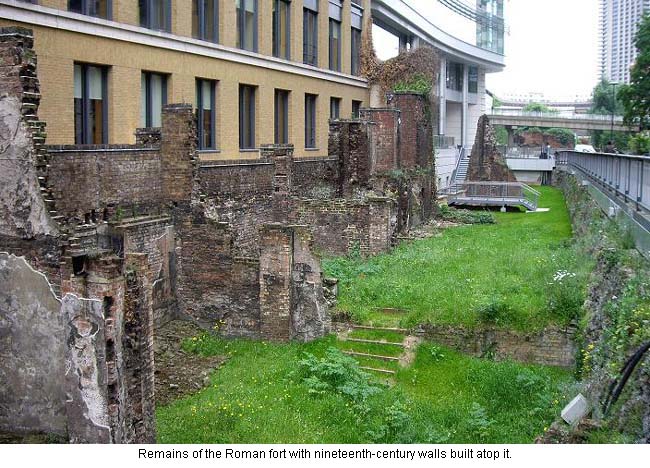A Tour of Roman London
by Sean McLachlan
London is such a vast and vibrant city, it's hard to imagine a
time when it wasn't a vital part of England's life, but before
the Romans arrived, there wasn't even a town here. When Julius
Caesar marched his legions through the land in 54 B.C., he found
nothing but a few scattered villages. The land was chalky and bad
for farming, and the Thames couldn't be forded anywhere downriver
of Westminster, making it more of a barrier than an asset to the
native Celts, who were brave warriors but poor sailors.

Julius Caesar decided not to expend the resources to bring the
island into the Roman sphere, but the Romans returned under the
emperor Claudius in 43 A.D. Claudius came with the intention of
making Britain a new province in the empire and quickly conquered
the various Celtic tribes, who were too divided to make a united
stand. While the land in the London basin was poor, the Romans
realized its strategic importance and built their provincial
capital here, naming it Londinium. The word comes from the Celtic
word lond, meaning wild, an indication of state in which
the Romans found it. They built a bridge just a few yards west of
where London Bridge stands today and Claudius himself visited the
city while on a tour of his new province.
There's a stereotype that Britannia, as the Romans called it, was
the backwater of the Empire, but in fact the province and its
capital thrived. Londinium's forum, where people met for commerce
and socializing, was the biggest outside of Italy, as was its
basilica, a building used for communal meetings in the days
before that type of architecture became associated with the
Christian church. At its height Londinium had a population of
about 30,000, making it one of the largest cities outside Italy,
with a busy international trade, rich villas, an amphitheatre,
and several temples.
Londinium stood in the area now known as Square Mile, or The
City, which remains the financial center of the British Isles to
this day, and if you know where to look you can still see some
remains from the Roman capital.

On Noble St., just south of the Museum of London, stands
a portion of the Roman fort built in 110 A.D. to protect the city
at its northwestern corner. Here you can see the foundations of
one of the towers and part of the wall. The wall atop it dates
from the nineteenth century, and it's interesting to see that
they built upon the old Roman foundations. This has been a common
practice throughout London's history, where newer buildings so
often get built atop the remains of previous ones, gradually
building up a new city from the old.
Continuing north past the pedestrian overpass at the
appropriately named London Wall Street are the remains of part of
the Roman city wall, built sometime around 200 A.D. from more
than a million blocks of stone hauled all the way from Kent in
southwest England on an estimated 1,750 barges. The wall
stretched for almost 3 kilometers (1.9 miles) and stood 6 meters
(20 feet) high and 2.4 (8 feet) thick at the base. The country
had long since been pacified, and the Anglo-Saxon invasions
wouldn't begin for another two centuries, so it seems the wall
was built for propaganda purposes, or as a way of employing the
urban mob, which had a bad habit of rioting when they weren't
getting enough to eat. Only the foundations survive, the wall and
postern tower above them date to the thirteenth century. If you
continue north for another hundred yards through the grassy area
you'll find another thirteenth century postern tower, also built
on Roman foundations. In the springtime, yellow and red
wildflowers bloom on its crumbling summit, making for a great
photograph. Another stretch of the Roman wall can be seen just
next to the Tower of London in the southeast corner of The
City.
While you are on London Wall Street, make sure to visit the
Museum of London, which covers the city's entire history from the
first Ice Age hunters to modern times. Each period has recreated
interiors such as a cramped Roman living room, complete with an
uncomfortable-looking toilet, and an entire street of Victorian
shops. The collection of Roman artifacts includes some
fascinating tools, jewelry, cultic statues, and other everyday
objects. From a large window near the Roman gallery you can look
out at the medieval tower and wall built on Roman foundations.

The most complete Roman building in the city is the second
century Temple of Mithras, at the corner of Queen and Queen
Victoria St. Workmen uncovered it during the rebuilding after the
Blitz of World War Two and, since it was in the way of some new
construction, reassembled it here. Mithras was the god of a late
Roman mystery religion that originated in Persia. The original
temple was underground and was the scene for religious banquets
and rituals. Mithraism was so popular it became the main rival to
early Christianity, but its secretive nature, and the fact that
it only accepted men as members, meant it eventually lost out.
The entire floor plan can clearly be seen, with colonnaded side
aisles where initiates could recline while sharing the sacred
banquet, and an altar at the back which once had a statue of
Mithras slaying a bull and thus bringing life to the world.
Other remnants of Londinium are scattered throughout the City. At
St. Bride's church on Fleet St., a visit to the crypt will reveal
the foundations of a sixth century Saxon church and a portion of
a Roman building with a decorated floor. While archaeologists are
unsure what the Roman building was used for, local legend says
St. Bride's is built on the site of a Celtic Christian community,
perhaps the earliest in the British Isles.
Beneath the Guildhall at Guildhall Yard is an even greater find,
part of an amphitheatre built in 70 A.D. so gladiators could
fight it out with wild animals (and each other) to the roaring of
the crowd. These bloody spectacles must have been popular,
because the amphitheatre was expanded in 200 A.D. to hold 6,000
people at a time when the population of Londinium numbered around
30,000.
While many Roman remains are in basements of later buildings,
some of Londinium's features are in plain view. Watling St., for
example, is an old Roman road that used to run from St. Albans
all the way to Wroxeter via Westminster, the probable site of the
first Roman fort in the area. You can still follow much of its
route today.
Other bits of Roman London are scattered throughout The City. On
the porch of St. Magnus the Martyr church on Lower Thames St. is
a beam from the Roman wharf found under Fish St., and
construction often reveals Roman layers of occupation. Keep an
eye on the newspapers when you're in town, because new finds are
made every year, and the archaeologists often let visitors view
the excavations. One of the strangest archaeological finds was in
1969 on the eastern edge of the old city wall, in an area called
Houndsditch. Excavators found eight dog skeletons from a layer
dating to the Roman period, an eerie testimony to the city's long
memory for names.
But as you make your tour of Roman London, spare a thought for
the brave Celts who fought and died to protect their lands from
the powerful empire. Legend has it that far below platform seven
of King's Cross Station lies the tomb of Boudicca, the female
leader of the Iceni. This warrior queen waged started a rebellion
the Romans in 60 A.D., laying waste to Verulamium (now St.
Albans) and other outlying towns before marching on Londinium.
She burned and looted the city but the Romans soon
counterattacked. An epic battle ensued in which thousands died,
supposedly near what the area that has throughout the city's
history been called Battlebridge. The Romans prevailed and
Boudicca, despairing, poisoned herself. While the rattle of the
trains might disturb her sleep, she can rest with the
satisfaction that she is more famous, and more admired by the
British, than any of the Romans who ever lived on her stolen
lands.
Related Articles:
- The Museum of London, by Kavitha Rao
- https://www.timetravel-britain.com/articles/london/museum.shtml
More Information:
We regret that we no longer have the resources to maintain up-to-date links and/or hours and pricing details for the various sites and attractions listed on this website. For more information about the location(s) listed above, please use your favorite search engine or visit Wikipedia.
Article and photos © 2008 Sean McLachlan
|
